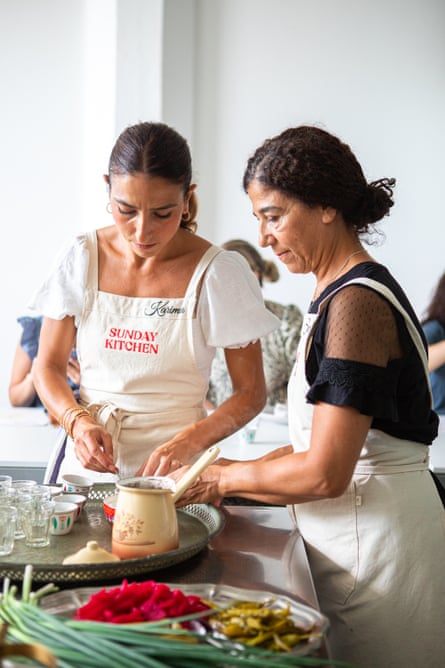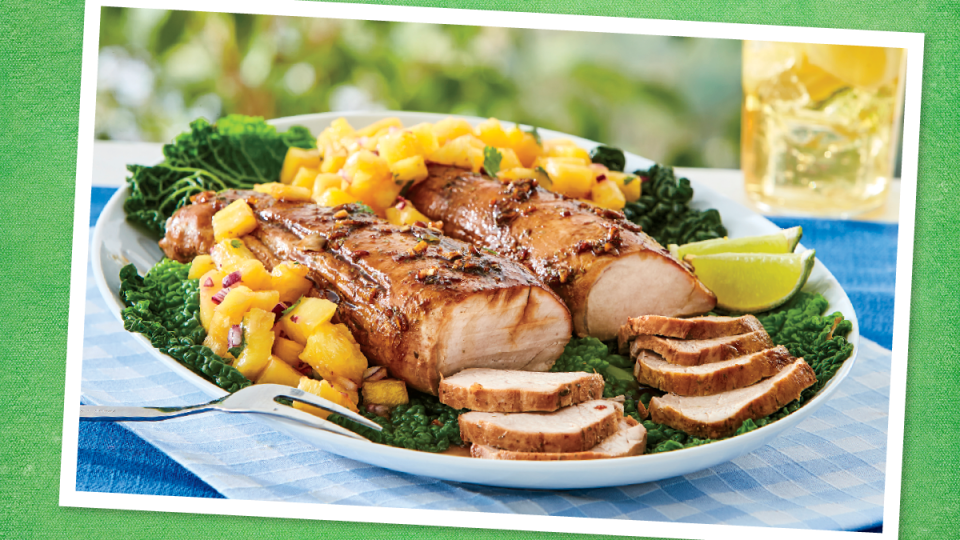My mother loved food, good food. And she loved cooking to bring us all together, especially over a big meal on the weekends. My passion – and my daughters’ passion – for doing the same was inherited from her. She cooked Lebanese dishes and so as I grew up, all I knew was Lebanese food and that’s what I continue to cook. If we wanted good Italian, we’d go to an Italian restaurant!
As my own children were growing up, Sunday mornings were particularly special. I felt it important to pass my mother’s and grandmother’s recipes down to them, and we cooked together.
Often my mother and my closest brother Jamal came for lunch and I would make samkeh harra, fish baked in a rich, silky and spicy tahini sauce in the traditional El Mina way. In the kitchen, I would sing along to Salemli Aleh by Fairouz.

As she got older, my mother cooked less and less, but she still insisted on helping. I used to ask her to prepare the eight bunches of parsley for the tabbouleh. She would arrive with two Lebanese bread bags full of washed and picked parsley. They were in perfect bundles, leaves collected on one end, stalks on the other. You could see the indentation in the stalks from the pegs that had held them on the washing line. That was her way of air-drying them after many rounds of washing.
Still today, Lebanon is divided on this issue: half will wash their parsley before chopping, and the other half will chop and then wash!
After my father died, my mother sold the family home in Sydney and fulfilled her dream of buying a house in El Mina, the harbour in Tripoli, Lebanon. She lived there for four years until she had a stroke and we brought her back to Sydney. My siblings and I created a cooking roster – she was pampered and never ate the same foods twice in any one day.
She never praised or made a fuss, and even when she became more fragile, she had a strong demeanour and would just nod in silence, chewing slowly, savouring each mouthful. Thankfully, she seemed to enjoy my cooking. I could see her pleasure when I cooked for her and challenged myself to delight her with each and every dish.
She never said it, but I think my mother particularly loved samkeh harra.
Although it’s eaten all over Lebanon, it is traditional and specific to Tripoli and reminded her of the El Mina port which was full of fish. At street stalls along the corniche samkeh harra came wrapped in Lebanese bread with salad, hot chips and tahini. I loved to cook it for her as a kind of consolation for losing her life there – not just what she had lost as a result of the war, but also from losing her final years of living there.
My only variation from the way my mother cooked samkeh harra is the sauce. It is traditionally made up of tahini, lemon juice, yoghurt, water, garlic, coriander, chilli and walnuts. When baked, the walnuts cause the tahini to turn an almost purplish-grey colour. It’s incredibly delicious but not visually appealing to fussy eaters (which my daughters were), so I leave the walnuts out, then brown them separately to dress the fish before serving.

I think of samkeh harra as my hero dish. My daughters and I still serve it the way my mother did, on a bed of sayadiyeh, a golden onion rice dish cooked in fish stock, which soaks up the tahini sauce. The side dishes, as is traditional, are always spicy potatoes (batata harra), tabbouleh, fried Lebanese bread and a smoky eggplant salad. This is one of my family’s favourite spreads during Ramadan.
Cooking my family’s recipes is part of my mother’s migration story – and part of mine and my daughters’. It was a way to keep doing the things we’d loved doing in Lebanon and a kind of therapy.
When we left Tripoli, I was a child. But the call and the tug of family roots, childhood memories and place of origin are so strong that, much as I love Australia and have made my home here, the land of my parents and my roots will always be in my heart and soul. I still I think of myself as a Trablousiyeh, a woman from Tripoli. If Lebanon were not so unstable, I might still choose to call Tripoli home.
Sivine Tabbouch’s samkeh harra recipe
I would encourage you to use a medium to large white-flesh fish such as snapper, or a blue-eye cod if you find one at your local fishmonger or the fish markets. Ask for the fish to be filleted on both sides, with the sides trimmed, and the skin left on. And ask for the head, body and tail in a separate bag to make the stock for the sayadiyeh.
after newsletter promotion
The tahini sauce can be prepared a few hours in advance. Use the best quality and most authentic Lebanese tahini you can find – Lebanese grocers are great for this.
Serves 4-6 as a main (depending on size of fish)
Prep 30 minutes
Cooking 30 minutes
1 whole white fish weighing 2-2.5kg, such as snapper or cod, cleaned, deboned and filleted into two large fillets with skin on, with head, tail and bones reserved (see note)
Olive oil
Handful raw walnuts
Neutral-flavoured oil (such as vegetable oil, grapeseed or canola), for frying
½ pomegranate, deseeded
Sayadiyeh, fried Lebanese bread, batata harra (spicy potatoes), tabbouleh and baba ghanosh, to serve
For the tahini sauce
4 garlic cloves, plus extra (to taste)
1 lemon, juiced
4 heaped tbsp Lebanese tahini
2 heaped tbsp Greek yoghurt
½ tbsp smoked paprika
½ tsp chilli powder
1 bunch coriander, leaves and stems finely chopped
Preheat oven to 180C fan. Place the fillets, skin-side down, on a large tray or dish, and rub all over with olive oil and a generous sprinkle of salt. Cover and refrigerate.
To make the tahini sauce, place the garlic cloves and a half tablespoon of salt (or to taste) in a mortar, and grind to a coarse paste. In a mixing bowl, combine the garlic paste and tahini, then gradually add the lemon juice, beating vigorously to break down the tahini and stop it from being stiff (you can also a tablespoon or so of water to help). Add the yoghurt, paprika and chilli powder and combine, then add about three cups of water, and combine again. Stir in the coriander. Taste for seasoning, and add more garlic and salt to taste. Refrigerate.
Heat a heavy-based ovenproof dish over high heat and sear the fish fillets, skin-side down. When the skins are golden-brown, remove the dish from the heat. Pour the tahini sauce over the fish and bake for 20 to 25 minutes (cooking time may vary depending on the size and thickness of the fillets).
Meanwhile, in a frying pan, heat a few tablespoons of neutral-flavoured oil over medium-high heat, and fry the walnuts until they turn golden. Remove from heat and take the walnuts out of the oil to stop them from cooking further.
After about 20 minutes of baking, use a large knife to poke the fish to check if it has cooked through. The flesh should be golden and the tahini sauce should have reduced and thickened slightly.
Remove the fish from the oven once cooked through and allow to stand for five minutes. Garnish the samkeh harra with pomegranate seeds and walnuts, and serve with sayadiyeh, fried Lebanese bread, batata harra, tabbouleh and baba ghanoush..
Note: Unless you are familiar with cleaning, gutting and filleting fish, ask your fishmonger to do this. Make sure you request the head, tail and bones are reserved in a separate bag, and use these to make a fish stock to cook your sayadiyeh to serve with the samkeh harra.
-
Sivine Tabbouch is the co-founder of Sunday Kitchen, a Sydney-based Lebanese cuisine cooking school she runs with her daughter Karima
-
This is an edited piece from Recipes for Ramadan, which has more than 65 Australian-Muslim recipes and stories from 23 countries. Follow the project on Instagram, Facebook and YouTube
from "recipes" - Google News https://ift.tt/76srVjl
via IFTTT

No comments:
Post a Comment